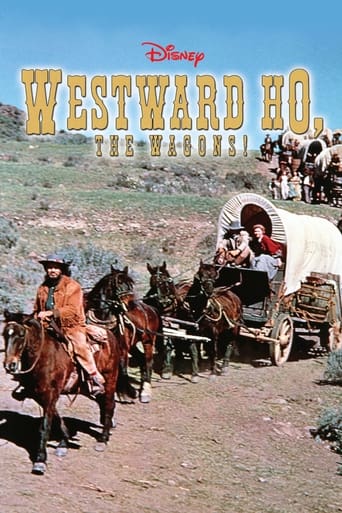bkoganbing
How well I remember seeing this film in theaters when it first opened back in 1956. For those of you not old enough to remember the Mickey Mouse Club attained a cult following among juveniles back then. So Westward Ho The Wagons had a built in audience before a dime was made at the theater box office.The dividing line between Walt Disney's television work and his theatrical work was invisible, both supported the other. As it happened back then his theatrical releases eventually were part of his Wonderful World of Color show and the films were built with the places obvious for commercial break.This was never more true than with Westward Ho The Wagon. In fact it's like two separate films spliced together, the better for a two part extravaganza on TV. The first part consists of the Oregon bound settlers fending off a Pawnee attack until they can get through a canyon gap. Once through they're in Sioux country where Chief Iron Eyes Cody has taken a fancy to little Karen Pendleton of the Mouseketeers because his medicine man says that blonds are scarce and little blonds bring good luck. Her sister Kathleen Crowley has a big divergence of opinion on that premise.In addition to the Mouseketeers playing children on the Oregon bound wagon train, the train has Fess Parker fresh from Davy Crockett as the scout. No doubt Parker's presence brought a few dollars in, he was another icon at this height of his career.Playing the head of the wagon train and father of several Mouseketeers is George Reeves who was making his final attempt to escape typecasting as Superman. Reeves wears a beard, the better to hide his well known face and be accepted as another actor in a role rather than in his iconic character from those days.Despite being episodic Westward Ho The Wagons holds up very well for today's audience if it were only seen. But Disney's old products for the most part are in the vault while we see endless reruns of Zack and Cody.
johnstonjames
there was no Dracula in this western. so i guess Beaudine fanz might be a tad disappointed. this also wasn't terribly exciting either and sort of deserves it's "westward ho-hum the wagguns" rep, and it is a little derogatory in it's depiction of the United States/native American conflict, but still, i enjoyed it immensely and found it very entertaining. then again, i'm partial to old school Disney films and i also happen to LOVE Fess Parker. so i think i'm bias here in my criticism.is there any such thing as a quasi-musical? if so, then i think this is one. there is not just one or two songs here, but at least four that i can think of, so i think this qualifies as practically a musical. not quite, but almost. it's also a reminder, that Fess Parker was really the last of the true singing cowboys. something Fessy is never given much credit for and something people who berate the film needlessly seem to forget. it's the kind of western where the singing cow dude is the draw, not the action sequences. if you're in this for the action sequences, you'll be a bit disappointed.the attitude toward native Americanos needs to be discussed and mentioned here too. sometimes the depiction of Indians is good and somewhat accurate, other times it's just plain racist and arrogant with the white settlers calling the Indians savages and ignorant heathens. not good unca Walt. but i can't exactly say John Ford's film masterpiece 'Stagecoach' is exactly sympathetic to the native American conflict either. but basically the attitude here is "whitey good. Indian bad and in need of big heap spankum".mostly i bought this movie because of Fessy and the Meeskateers. Doreen Tracey plays BoBo Stephen. no academy award here but she plays a BoBo very well. Cubby O'Brien and Karen are here also for a little added scrumptious cuteness. Marty, of 'Spin & Marty' Disney fame, basically plays himself. Tommy is here fer the ol' role call too. i miss Annette though. Annette would have really livened things up. she could have sung a duet with Fessy.
dougbrode
This is one of several westerns that the Walt Disney studio tailored for Fess Parker in the years immediately following Davy Crockett's success. The first half hour is an enjoyable but relatively routine wagon trail tale, involving a stalwart boy (David Stollery, of Spin and Marty fame) who, like the legendary John Colter, must run from hostile Indians on foot. The action-oriented first half culminates in a rugged shootout that action-western fans will enjoy. In the minds of many, Westward Ho slows down there as the train arrives in Fort Laramie and no further big battles occur. In fact, this is where the movie takes off dramatically, promoting the sort of racial tolerance and mutual acceptance so essential to the Disney vision. Parker is a doctor, and along with a Lakota medicine man (Iron Eyes Cody), helps a dying Indian boy. "Two medicines are better than one" is the message, and a beautiful one at that, suggesting that mutual cooperation is indeed possible between the races. Fess even gets to sing several sings, and one of them, "Wringle Wrangle," became a top ten hit. This is a forgotten treat, waiting to be rediscovered.
moonspinner55
Fess Parker is his usual stolid self leading wagon train to Oregon, crossing paths with bloodthirsty Pawnee tribe. Fans were attracted to Parker's workmanlike acting style and amiable, almost-shy personality. He's a headliner simply by default. This Disney film has nice outdoor scenery, some strong scenes of survival and a good supporting cast (including hammy, amusing Sebastian Cabot and a few Mouseketeers); otherwise, it's a formula-bound, banal sagebrush saga. B-grade director William Beaudine does his usual anonymous work behind the camera. Tom Blackburn adapted his screenplay from Mary Jane Carr's book, "Children of the Covered Wagon" (also the film's pre-production title). ** from ****





